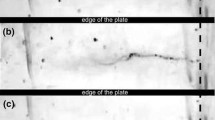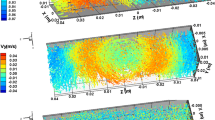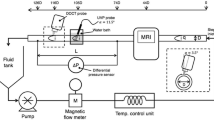Abstract
Currently, there are a number of flow diagnostic tools available for the evaluation of fluid dynamic systems. In spite of its great potential, holographic velocimetry is one technique which has not been widely used. It does, however, have great potential in this area due to its inherent three-dimensionality. As demonstrated in this study of fully developed turbulent flow in a pipe, full three-dimensional mapping can be achieved at any instant in a flow cycle. Comparisons of holographic results with analytical predictions and laser-Doppler-anemometry (LDA) measurements demonstrate the accuracy of the technique as well as some of its advantages and disadvantages relative to LDA. Although relatively poor spatial resolution is obtained, the fact that holographic velocimetry is both an instantaneous and full volume measuring tool makes it useful for a range of complex and high-speed flow-measurement applications.
Similar content being viewed by others
References
Skidmore, R., “Basic Techniques in Doppler Cardiology,” Proc. Physical Techniques in Cardiological Imaging, 47–54 (1982).
Hwang, N., “Flow Dynamics of Natural Valves in the Left Heart,”Cardiovascular Flow Dynamics and Measurements, ed. N. Hwang andN.A. Normann, University Park Press, Baltimore, Ch. 21, 825–850 (1977).
Fabris, G., “Probe and Method for Simultaneous Measurements of ‘True’ Instantaneous Temperature and Three Velocity Components in Turbulent Flow,”Rev. Sci. Instr.,49 (5),654–664 (May 1978).
Tombach, I.H., “An Evaluation of the Heat Pulse Anemometer for Velocity Measurement in Inhomogeneous Turbulent Flow,”Rev. Sci. Instr.,44 (2),141–148 (Feb. 1973).
Drain, L.E., The Laser Doppler Technique, John Wiley & Sons, New York, Ch. 1, 4–5 (1980).
Huffaker, R.M., “Laser Doppler Detection Systems for Gas Velocity Measurement,”Appl. Opt.,9 (5),1026–1039 (May 1970).
Grant, G.R. andOrloff, K.L., “Two-Color Dual-Beam Backscatter Laser Doppler Velocimeter,”Appl. Opt.,12 (12),2913–2916 (Dec. 1973).
Blake, K.A., “Simple Two-Dimensional Laser Velocimeter Optics,”J. of Physics E: Sci. Instru.,5 (7),623–624 (July 1972).
Privette, R.M., Tiederman, W.G. andPhillips, W.M., “Cycle-To-Cycle Variation in Pulsatile Valve Flows,”Proc. ACEMB,39,130 (1986).
Barker, D.B. andFourney, M.E., “Measuring Fluid Velocities with Speckle Patterns,”Opt. Lett.,1 (4),135–137 (Oct. 1977).
He, Z.H., Sutton, M.A., Ranson, W.F. andPeters, W.H., “Two-dimensional Fluid-velocity Measurements by Use of Digital-speckle Correlation Techniques,” experimental mechanics,24 (2),117–121 (June 1984).
Yoganathan, A.P., Cardiovascular Fluid Mechanics, PhD Thesis, Cal. Inst. of Tech., Pasadena (1978).
Goodman, J.W., Introduction to Fourier Optics, McGraw-Hill, New York, 214–218 (1968).
Collier, R.J., Burckhardt, C.B. andLin, L.H., Optical Holography, Academic Press, Inc., Orlando, Ch. 11, 328–330 (1971).
Neumann, D.B., “Holography of Moving Scenes,”J. Opt. Soc. Amer.,58 (4),447–454 (April 1968).
Kurtz, R.L. andPerry, L.M., “Real-Time Holographic Motion Picture Camera Capable of Recording Front Surface Detail from a Random Velocity Vector,”Appl. Opt. 12 (12),2815–2821 (Dec. 1973).
Redman, J.D., “Holographic Velocity Measurement,”J. Sci. Instr.,44 (12),1032–1033 (Dec. 1967).
Fourney, M.E., “Aerosol Size and Velocity Determination via Holography,”Rev. Sci. Instr.,40 (2),205–213 (Feb. 1969).
Trolinger, J.D., Belz, R.A. and Farmer, W.M., “Holographic Techniques for the Study of Dynamic Particle Fields,” AEDC-TR-68-215 (Sept. 1968).
Shofner, F.M., Menzel, R. and Russell, T.G., “Fundamentals of Holographic Velocimetry,” AFFDL-TR-68-140 (Nov. 1968).
Shofner, F.M., Webb, R.O. and Fradenburg, R.L., “Optical Data Processors for Holographic Velocimetry,” Laser J., 13–17 (March/April 1970).
Menzel, R., Russell, T.G. andShofner, F.M., “Recording Fluid Velocity Fields Holographically,”Proc. Soc. Photo-optical Instr. Eng.,15,167–170 (May 1968).
Thompson, B.J., Parrent, G.B., Ward, J.H. andJusth, B., “A Readout Technique for the Laser Fog Disdrometer,”J. Appl. Meteor.,5 (3),343–348 (June 1966).
Hjelmfelt, A.T., Jr. andMockros, L.F., “Motion of Discrete Particles in a Turbulent Fluid,”J. Appl. Sci. Res. 16,149–161 (1966).
Yoganathan, A.P., personal communication (Dec. 1987).
Agfa-Gevaert NDT/Holography Technical Information (1983).
Knox, C., “Holographic Microscopy as a Technique for Recording Dynamic Microscopic Subjects,”Sci. 153,989–990 (Aug. 1966).
Haussmann, G. andLauterborn, W., “Determination of Size and Position of Fast Moving Gas Bubbles in Liquids by Digital 3-D Image Processing of Hologram Reconstructions,”Appl. Opt.,19 (20),3529–3535 (Oct. 1980).
Lauterborn, W. andHentschel, W., “Cavitation Bubble Dynamics Studied by High Speed Photography and Holography: Part Two,”Ultrasonics,24 (2),59–65 (March 1986).
Thompson, B.J., Ward, J.H. andZinky, W.R., “Application of Hologram Techniques for Particle Size Analysis,”Appl. Opt.,6 (3),519–526 (March 1967).
Silverman, B.A., Thompson, B.J. andWard, J.H., “A Laser Fog Disdrometer,”J. Appl. Meteor.,3 (6),792–801 (Dec. 1964).
Briones, R.A., Heflinger, R.O. andWuerker, R.F., “Holographic Microscopy,”Appl. Opt.,17 (6),944–950(March 1978).
Ebeling, K.J., “Application of High Speed Holocinematographical Methods in Cavitation Research,”Proc. of the First International Conf. on Cavitation and Inhomogeneities in Underwater Acoustics, ed. W. Lauterborn, Springer-Verlag, Heidelberg, Part I, 35–41 (1980).
Hecht, E. andZajac, A., Optics, Addison-Wesley Publishing Company, Reading, Ch. 10 350–352 (1979).
Parrent, G.B., Jr. andThompson, B.J., “On the Fraunhofer (Far Field) Diffraction Patterns of Opaque and Transparent Objects with Coherent Background,”Opt. Acta,11,183–193 (Feb. 1964).
Hecht, E. andZajac, A., Optics, Addison-Wesley Publishing Company, Reading, Ch. 10, 387–388 (1979).
DeVelis, J.B., Parrent, G.B., Jr. andThompson, B.J., “Image Reconstruction with Fraunhofer Holograms,”J. Opt. Soc. Amer.,56 (4),423–427 (April 1966).
Brighton, J.A. andHughes, W.F., Fluid Dynamics, McGraw-Hill Book Company, New York, Ch., 5, 87–90 (1967).
Golden Software, Inc. Surfer Manual Technical Information (1987).
Author information
Authors and Affiliations
Rights and permissions
About this article
Cite this article
Schuster, P.R., Wagner, J.W. Holographic velocimetry for flow diagnostics. Experimental Mechanics 28, 402–408 (1988). https://doi.org/10.1007/BF02325183
Received:
Revised:
Issue Date:
DOI: https://doi.org/10.1007/BF02325183




